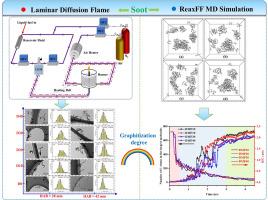Analysis of the nanostructure evolution of soot in n-heptane/iso-octane with 2,5-dimethylfuran addition: A combined experimental study and ReaxFF MD simulations
IF 6.2
2区 工程技术
Q2 ENERGY & FUELS
引用次数: 0
Abstract
The soot formation of n-heptane/iso-octane doped 2,5-dimethylfuran (DMF) with different ratios was experimentally investigated through laminar diffusion flame and numerically simulated by using the pyrolysis simulations method of reactive force field molecular dynamics (ReaxFF MD). The results showed that the laminar diffusion flame height of n-heptane/iso-octane increased with increasing DMF doping ratio. At a consistent sampling height, the primary soot particle sampling numbers collected were first decreasing and then increasing, and the size of the primary soot particle was first increasing and then decreasing accompanied by the DMF doping ratio increasing. Furthermore, the transmission electron microscope (TEM) analysis provided that DMF initially inhibited and subsequently promoted the primary soot particle growth in the n-heptane/iso-octane flame. The core-shell ratio increased and then decreased with the increase of the DMF doping ratio, which indicated that the maturity of soot decreased and then increased. In n-heptane/iso-octane doped with DMF ReaxFF MD pyrolysis simulation, it was divided into three stages 0–0.5 ns (the first stage), 0.5–3 ns (the second stage), and 3–4.5 ns (the third stage). Fuel decomposed in the first stage and reacted violently in the second stage. The soot precursors continued to react, molecule size kept to increase, and the polycyclic aromatic hydrocarbons (PAHs) continued to grow. In the third stage, the carbon number of the largest molecules were slowly increasing, and the development of soot entered mature stage, where the H/C ratio was slowly decreasing. Through ReaxFF MD simulations, it was found that the maturity of soot exhibited decreasing and then increasing trend with the increase of DMF doping ratio. The graphene-like structures were mainly concentrated around the H/C ratio of 0.297 region.

分析正庚烷/异辛烷中添加 2,5 二甲基呋喃后烟尘的纳米结构演变:实验研究与 ReaxFF MD 模拟相结合
通过层流扩散火焰实验研究了不同比例的正庚烷/异辛烷掺杂2,5-二甲基呋喃(DMF)的烟尘形成,并利用反应力场分子动力学(ReaxFF MD)的热解模拟方法对其进行了数值模拟。结果表明,正庚烷/异辛烷的层流扩散火焰高度随 DMF 掺杂比例的增加而增加。在采样高度一致的情况下,采集到的一次烟尘颗粒采样数先减后增,一次烟尘颗粒的尺寸也随着 DMF 掺杂比的增大先增大后减小。此外,透射电子显微镜(TEM)分析表明,DMF 最初抑制了正庚烷/异辛烷火焰中一次烟尘粒子的生长,随后又促进了其生长。随着 DMF 掺杂比的增加,核壳比先增大后减小,这表明烟尘的成熟度先减小后增大。在掺杂了 DMF 的正庚烷/异辛烷 ReaxFF MD 热解模拟中,分为 0-0.5 ns(第一阶段)、0.5-3 ns(第二阶段)和 3-4.5 ns(第三阶段)三个阶段。燃料在第一阶段分解,在第二阶段发生剧烈反应。烟尘前体继续发生反应,分子尺寸不断增大,多环芳烃(PAHs)继续增加。第三阶段,最大分子的碳数缓慢增加,烟尘发展进入成熟阶段,H/C 比值缓慢下降。通过 ReaxFF MD 模拟发现,随着 DMF 掺杂比例的增加,烟尘的成熟度呈现先减小后增大的趋势。类石墨烯结构主要集中在 H/C 比为 0.297 的区域。
本文章由计算机程序翻译,如有差异,请以英文原文为准。
求助全文
约1分钟内获得全文
求助全文
来源期刊

Combustion and Flame
工程技术-工程:化工
CiteScore
9.50
自引率
20.50%
发文量
631
审稿时长
3.8 months
期刊介绍:
The mission of the journal is to publish high quality work from experimental, theoretical, and computational investigations on the fundamentals of combustion phenomena and closely allied matters. While submissions in all pertinent areas are welcomed, past and recent focus of the journal has been on:
Development and validation of reaction kinetics, reduction of reaction mechanisms and modeling of combustion systems, including:
Conventional, alternative and surrogate fuels;
Pollutants;
Particulate and aerosol formation and abatement;
Heterogeneous processes.
Experimental, theoretical, and computational studies of laminar and turbulent combustion phenomena, including:
Premixed and non-premixed flames;
Ignition and extinction phenomena;
Flame propagation;
Flame structure;
Instabilities and swirl;
Flame spread;
Multi-phase reactants.
Advances in diagnostic and computational methods in combustion, including:
Measurement and simulation of scalar and vector properties;
Novel techniques;
State-of-the art applications.
Fundamental investigations of combustion technologies and systems, including:
Internal combustion engines;
Gas turbines;
Small- and large-scale stationary combustion and power generation;
Catalytic combustion;
Combustion synthesis;
Combustion under extreme conditions;
New concepts.
文献相关原料
公司名称
产品信息
阿拉丁
DMF
阿拉丁
iso-octane
阿拉丁
n-heptane
 求助内容:
求助内容: 应助结果提醒方式:
应助结果提醒方式:


